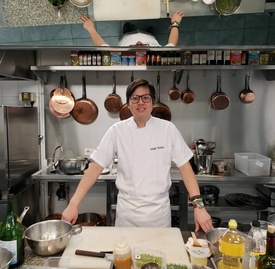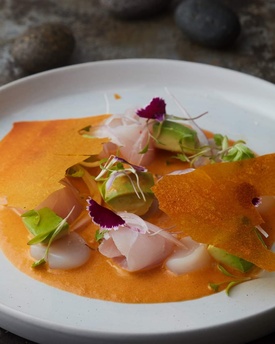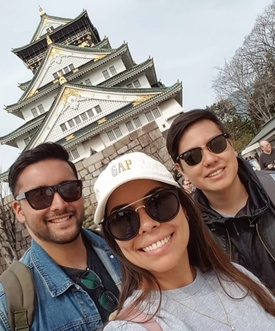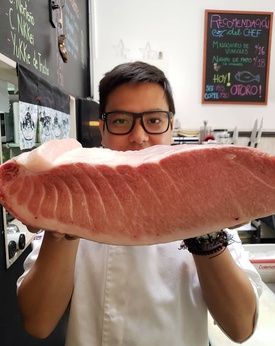
As with many Nikkei, appearances can be deceiving when looking at Coco Tomita Naganamine . He arrives in a hurry, a little disheveled, with a backpack on his shoulder, like in his schoolboy days in La Unión, to take care of the responsibility of an adult: running the Shizen Barra Nikkei restaurant, which he opened in 2017 with his chef friends Renato Kanashiro and Mayra Flores. At 28 years old, Coco is a chef, businessman and teacher of Japanese cuisine.
He says that when he was about to leave school he did not know what he wanted to study, that that year he began to cook more frequently and that his taste for food came from his grandmother, who made a type of cuisine that was a homemade mix of Peruvian cuisine. and Japanese. He liked large family banquets, for more than a hundred people, where his grandmother prepared whole fish and everything was a party. “She made Peruvian dishes, like olluquito or cau cau, and other Japanese dishes but with a Peruvian touch.”
Since that time he has been a friend of Renato Kanashiro, with whom he studied Restaurant Management and Administration at Le Cordon Bleu Perú. There, their thesis was Shizen Sushi Catering, a business they started in 2013 and that had a more traditional Japanese style with a touch of fusion. “We had some orders but they were sporadic,” says Coco. In 2015 they decided to change the concept and called themselves Shizen Nikkei Food. The change seems slight but the impact was transcendent.
A natural fusion
When Renato introduced Mayra Flores and Coco Tomita, these two chefs had a common, opposite but complementary interest: knowing each other's ancestral cuisine. Mayra is from Piura and until that time Coco only knew the Creole food they prepared at home, with a strong Japanese component. Mayra wanted to learn Japanese cuisine and so the three became partners in this project called Shizen, which means nature, and with which they have achieved a natural fusion as has been the mixture of Peruvian and Japanese cuisines since their origins.
“It is the perfect marriage of two cultures,” says Coco about both culinary aspects that in Shizen take one of the paths less traveled: traditional regional cuisines from all over Peru, and Japanese technique and inputs. The sea, from the northern province of Piura and the Japanese culinary tradition, was present in their preparations. “Can you imagine this in a restaurant?” was the question Renato asked before opening the establishment on a quiet street in Miraflores.
Piura's cuisine, with character, with intensely flavored dressings, was a revelation for Coco, who at home had only tried gohan , rice without dressing, very different from the Creole one that is prepared with garlic. Coco, a fish enthusiast, tried new species in the north and was encouraged to incorporate unusual marine products into Shizen such as mackerel, horse mackerel, liza, diablo and bonito that, well prepared, produce renewed flavors for a diner accustomed to every increasingly scarce marine species such as croaker and sole. “We make sustainable cuisine, with respect for the products,” she adds, adjusting her hair.
Peruvian bar

Shizen is the first Peruvian Nikkei bar. Mixture of sushi bar and cebichera bar where there are hot and cold dishes, whole fish served to the customer's taste and permanent innovations. “We are inventing dishes all the time,” says Coco, adding that the three of them are involved in the kitchen, they are a team that works perfectly thanks to the fact that they work for a common cause, without egos and in harmony. “We are like a puzzle, they had a part and I had the missing piece,” says Mayra in a television interview .
Since they opened, the three partners have received a lot of attention from the press, as well as very good comments for their dishes. A key may lie in the trips they undertook throughout Peru, from Piura to Tacna, passing through Iquitos, Huancayo, Arequipa, Ayacucho and many other cities with a clear idea: to learn from the traditional cuisines of each place.
“It was a trip to get to know Peru. We wanted to know the reality of each region to understand its cuisines and internalize them, valuing the work that the producers do,” says Coco, who also highlights the contribution of the Japanese tradition of Peruvian chefs such as Humberto Sato, Toshiro Konishi, the Matsufuji family and Mitsuharu Tsumura. “We young people are lucky to continue working on the generational legacy, more than a fusion, we are part of Peruvian culture, with nuances and the inheritance of Japanese traditions,” he says in another television interview.
The bar concept, where what the sea throws up is prepared and menus are put together in which dishes can be exchanged, is an innovation within Nikkei cuisine, so lent to the maki bars with 'all you can eat'. Here you can find dishes such as chirashi (moriawase sashimi), tantanmen (ramen stock with Creole dressing), grilled shells with liquefied rocoto and ponzu , and kaki fry (crispy oysters).
grow and learn
In recent years, Coco has taught cooking classes at the Argentine Institute of Gastronomy, at Urban Kitchen in Peru and at Cocina Lab, which operates virtually (and in 2020, she will begin teaching at the Pontificia Universidad Católica del Perú). He has attended gastronomic fairs 1 , he has cooked on television, in other restaurants as a guest and he has made some trips that have been part of his continuous learning in the world of cooking, such as in Arequipa, where he woke up at four in the morning to learn how to make the marinade.

But perhaps the most valuable lesson came in March 2019 when the three partners went to Japan. “We were in Osaka, Kyoto, Nagoya and Tokyo. Something that surprised me in Japan is that you can eat delicious food anywhere, there are restaurants that are more than 200 years old,” says Coco, who learned more about otoro, a type of tuna, of which the Japanese use the ventrusca. “Everything uses fish,” says the chef, who believes that there is a lot to experiment and grow in Nikkei cuisine.
Coco's territory is the sea and the port or, more specifically, the markets where the rare marine species that he seeks to discover arrive. At Shizen Barra Nikkei a classic is the tiradito, with Nikkei tiger milk made with smoked rocoto, shells, fish, avocado and sweet potato cookie (or if you prefer you can combine it with other products from the bar). They also have nigiris (from silverside, Andean trout or barnacles); makis or creative dishes such as chupe ramen, or usuzukuri (a super fine sashimi) in ponzu sauce and chicha de jora, a first in Nikkei restaurants.
Urchins, trout eggs, quail eggs, razor clams, oysters, ikura (salmon eggs) and ponzu gel are some of the ingredients that may surprise you in a menu that is a sample of the openness of Peruvian cuisine that, like says Coco Tomita, she welcomes others with open arms and always with something new. “We are using hon maguro, which is a delicacy in Japan and we are sure you will like it a lot.”
Note:
1. Marcelo Pavazz, “ Four by four ”, El Planeta Urbano logo (August, 2019)
© 2020 Javier García Wong-Kit







